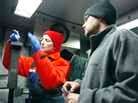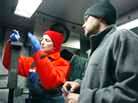
A New Approach to Dressing for the Cold
The new ANSI/ISEA 201 standard for thermal garments will help in selecting cold-weather gear.
- By Tim J. Gardner, Janice Comer Bradley
- May 01, 2009
 When temperatures drop, people who have to work outdoors usually prepare for cold weather by layering up. They add a hoody, a hat, a fleece, a vest--even a parka if it's really bad--then make the best of it to get the job done. This approach has helped people get by for a long time, but now a new standard from the International Safety Equipment Association (ISEA) will make it possible to apply more science to this PPE challenge.
When temperatures drop, people who have to work outdoors usually prepare for cold weather by layering up. They add a hoody, a hat, a fleece, a vest--even a parka if it's really bad--then make the best of it to get the job done. This approach has helped people get by for a long time, but now a new standard from the International Safety Equipment Association (ISEA) will make it possible to apply more science to this PPE challenge.
Cold weather can be a serious hazard for workers who have no choice but to complete a task when a rescue, emergency repair, or construction responsibility falls to them. Frostbite and hypothermia usually come to mind, but other accidents not directly related to weather, such as falls or struck-bys, become more likely when workers get cold and their bodies don't work as well. Bulky clothing can be clumsy and contribute to the loss of dexterity. Being cold by itself can be a distraction that makes complex tasks both more challenging and dangerous.
Some organizations are highly experienced at working in frigid environments and rely on years of practice to know what kind of clothing is best for their workers. Other companies may have no program to prepare their employees to work in the cold.
The new standard, ANSI/ISEA -- 201 American National Standard for Insulating Apparel used in Cold Work Environments, incorporates the latest textile science to improve the effectiveness of the approach that safety officers, apparel specifiers, employers, garment makers, and workers can take to protect workers from cold-weather hazards.
So how does it work? The ANSI/ISEA 201 standard requires that cold-weather garments be evaluated and labeled for their insulating properties. Insulating properties of apparel are evaluated using the standard test method ASTM 1292 and expressed in a clo value. Clo is the unit of insulative value for clothing, similar to the familiar R-value for home insulation. Numerically, 1 clo = 0.155 K m2/W. Put another way, 1 clo unit is the insulation that maintains normal body temperature for a person sitting still in a 70ºF room, approximately equivalent to a business suit.
Label Information Aids Selection
For users, the key to the standard is a label that will provide information to make garment selection based on the work environment and tasks. The label will bear a numerical rating for thermal performance and an insulation range. The label also reports a durability class for laundering.
Thermal performance will be rated from number 1 to 6, based on the range of the clo value, with category 1 garments providing insulating properties of the average business suit and category 6 providing the greatest degree of insulation.
The label also will display a durability class, which shows how the garment will retain insulating properties over a number of standard cleaning cycles specified by the garment maker. ANSI/ISEA 201 durability classes range from Class 1 with five wash cycles to Class 4 requiring 50 repetitions.
This standard provides a new approach for users in a variety of cold environments from mild to extreme to select garments based on the clo value and add garments to meet their needs. The use of clo values for insulating properties will provide a numerical thermal performance of a single garment or multiple garments as they are added for more extreme cold.
The ANSI/ISEA 201 standard has appendices that reference numerous existing standards and information on cold weather clothing. A flow-chart was developed to assist users to evaluate clothing needs based on the expected environment. Rather than reinventing the wheel, the ANSI/ISEA 201 standard references other existing clothing measurement test methods and gathers them into a standardized approach for matching insulating protective clothing with environmental conditions and work conditions.
A close complementary relationship exists between ANSI 201 and another new standard, ASTM 2732, Standard Practice for Determining the Temperature Rating for Cold Weather Protective Clothing. The temperature rating that comes from ASTM 2732 brings practical, intuitive information to the ANSI 201 garment label. ASTM 2732 also helps to define the standard conditions, such as base clothing configurations for measurements and work rate, that establish a reproducible performance baseline. The reference point is established as light work, defined as 2 MET. A MET is the unit of metabolic rate, and 1 MET = 58 W/m2. For example, 2 MET is about twice the energy an average person uses awake and sitting still, and it is considered light work. The temperature ratings apply to single garments, while the clo values may be used additively to estimate the approximate protection of the complete ensemble.
Prototypical User: North Dakota Utility Worker
When a committee works on a standard, its members must continually consider its usefulness for the intended user. The ISEA Protective Apparel Group considered a prototypical user of insulative garments to be a North Dakota utility worker. This is a person who not only has to survive outside at -30ºF temperatures, but also may have to do it in the wind at the top of a utility pole while making a complicated systems repair. For such workers, clothing is not just for comfort, it's personal protective equipment (PPE) that guards against significant hazards while they work.
An even more extreme but similar case that sometimes came up is a worker on the North Slope in the Arctic. A third group among the many examples the committee considered would benefit from the new standard would be workers who rarely face the cold. How's that? Because they would have less practical experience with low-temperature weather, a standard such as ANSI/ISEA 201 can provide valuable guidance on selecting PPE appropriate to protect workers in conditions unusual to them, rather than having to guess how to prepare when they head out into an emergency.
The value of the ANSI/ISEA 201 standard is that it provides specifiers, safety officers, and users a way to evaluate their cold-weather garment needs and allows them to write specifications for and assign PPE classified by reproducible measurements. It brings together in a practical user document other standards and information related to cold weather and does so in a way that embodies the values of the ISEA, to promote high-quality, durable, dependable PPE that users can rely on. Anyone who uses cold-weather garments certified to ANSI/ISEA 201 can be sure the clothing will suitable for its intended use over its expected lifetime.
ANSI/ISEA --
201-2009 American National Standard for Insulating Apparel used in Cold Work Environments is available from ISEA. For more information, visit
www.safetyequipment.org.